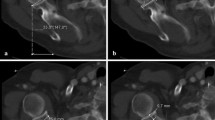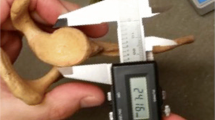Abstract
Introduction
Variations in glenoid morphology among patients of different gender, body habitus, and ethnicity have been of interest for surgeons. Understanding these anatomical variations is a critical step in restoring normal glenohumeral structure during shoulder reconstruction surgery.
Methods
Retrospective review of 108 patient shoulder CT scans was performed and glenoid version, AP diameter and height were measured. Statistical multiple regression models were used to investigate the ability of gender and ethnicity to predict glenoid AP diameter, height, and version independently of patient weight and height.
Results
The mean glenoid AP diameter was 24.7 ± 3.5, the mean glenoid height was 31.7 ± 3.7, and the mean glenoid version was 0.05 ± 9.05. According to our regression models, males would be expected to exhibit 8.4° more glenoid retroversion than females (p = 0.003) and have 2.9 mm larger glenoid height compared to females (p = 0.002). The predicted male glenoid AP diameter was 3.4 mm higher than that in females (p < 0.001). Hispanics demonstrated 6.4° more glenoid anteversion compared to African-Americans (p = 0.04). Asians exhibited 4.1 mm smaller glenoid AP diameters than African-Americans (p = 0.002). An increase of 25 kg in patient weight resulted in 1 mm increase in AP diameter (p = 0.01).
Conclusions
Gender is the strongest independent predictor of glenoid size and version. Males exhibited a larger size and more retroverted glenoid. Patient height was found to be predictive of glenoid size only in patients of the same gender. Although variations in glenoid size and version are observed among ethnicities, larger sample size ethnic groups will be necessary to explore the precise relations. Surgeons should consider gender and ethnic variations in the pre-operative planning and surgical restoration of the native glenohumeral relationship.
Level of Evidence: Anatomic Study






Similar content being viewed by others
References
Budge MD, Lewis GS, Schaefer E, Coquia S, Flemming DJ, Armstrong AD (2011) Comparison of standard two-dimensional and three-dimensional corrected glenoid version measurements. J Shoulder Elb Surg 20(4):577–583
Friedman RJ, Hawthorne KB, Genez BM (1992) The use of computerized tomography in the measurement of glenoid version. J Bone Joint Surg Am 74(7):1032–1037
Matsumura N, Ogawa K, Kobayashi S, Oki S, Watanabe A, Ikegami H, Toyama Y (2014) Morphologic features of humeral head and glenoid version in the normal glenohumeral joint. J Shoulder Elb Surg 23(11):1724–1730
Sabesan VJ, Callanan M, Youderian A, Iannotti JP (2014) 3D CT assessment of the relationship between humeral head alignment and glenoid retroversion in glenohumeral osteoarthritis. J Bone Joint Surg Am 96(8):e64
Iannotti JP, Weiner S, Rodriguez E, Subhas N, Patterson TE, Jun BJ, Ricchetti ET (2015) Three-dimensional imaging and templating improve glenoid implant positioning. J Bone Joint Surg Am 97(8):651–658
Brems J (1993) The glenoid component in total shoulder arthroplasty. J Shoulder Elb Surg 2(1):47–54
Brems J, Churchill RS, Kotschi H (2001) Glenoid size, inclination, and version: an anatomic study. J Shoulder Elb Surg 10(4):327–332
Lewis GS, Armstrong AD (2011) Glenoid spherical orientation and version. J Shoulder Elb Surg 20(1):3–11
Hohmann E, Tetsworth K (2015) Glenoid version and inclination are risk factors for anterior shoulder dislocation. J Shoulder Elb Surg 24(8):1268–1273
Powell K, Kwon YW, Yum JK, Brems JJ, Iannotti JP (2005) Use of three-dimensional computed tomography for the analysis of the glenoid anatomy. J Shoulder Elb Surg 14(1):85–90
De Wilde LF, Berghs BM, VandeVyver F, Schepens A, Verdonk RC (2003) Glenohumeral relationship in the transverse plane of the body. J Shoulder Elb Surg 12(3):260–267
Lenart BA, Freedman R, Van Thiel GS, Dhawan A, McGill KC, Basu S, Meyer JR, Provencher CM, Cole BJ, Romeo AA, Verma NN (2014) Magnetic resonance imaging evaluation of normal glenoid length and width: an anatomic study. Arthroscopy 30(8):915–920
Edelson G (1999) Variations in the retroversion of the humeral head. J Shoulder Elb Surg 8(2):142–145
Bockmann B, Soschynski S, Lechler P, Ruchholtz S, Debus F, Schwarting T, Frink M (2016) Age-dependent variation of glenohumeral anatomy: a radiological study. Int Orthop 40(1):87–93
Ricchetti ET, Hendel MD, Collins DN, Iannotti JP (2013) Is premorbid glenoid anatomy altered in patients with glenohumeral osteoarthritis? Clin Orthop Relat Res 471(9):2932–2939
Farron A, Terrier A, Buchler P (2006) Risks of loosening of a prosthetic glenoid implanted in retroversion. J Shoulder Elb Surg 15(4):521–526
Matsen FA 3rd (2015) The ream and run: not for every patient, every surgeon or every problem. Int Orthop 39(2):255–261
Hoenecke HR Jr, Hermida JC, Flores-Hernandez C, D’Lima DD (2010) Accuracy of CT-based measurements of glenoid version for total shoulder arthroplasty. J Shoulder Elb Surg 19(2):166–171
Rouleau DM, Kidder JF, Pons-Villanueva J, Dynamidis S, Defranco M, Walch G (2010) Glenoid version: how to measure it? Validity of different methods in two-dimensional computed tomography scans. J Shoulder Elb Surg 19(8):1230–1237
Andrin J, Macaron C, Pottecher P, Martz P, Baulot E, Trouilloud P, Viard B (2016) Determination of a new computed tomography method for measuring the glenoid version and comparing with a reference method. Radio-anatomical and retrospective study. Int Orthop 40(3):525–529
Poon PC, Ting FS (2012) A 2-dimensional glenoid vault method for measuring glenoid version on computed tomography. J Shoulder Elb Surg 21(3):329–335
Green S (1991) How many subjects does It take to do a regression analysis. Multivar Behav Res 26(3):499–510
Morgan B, Voorhis CRWV (2007) Understanding power and rules of thumb for determining sample sizes. Tutor Quant Methods Psychol 3(2):43–50
Author information
Authors and Affiliations
Corresponding author
Ethics declarations
Conflict of interest
The authors declare that they have no conflict of interest.
Statement for human rights
The study was approved by the University of Illinois at Chicago IRB. The IRB protocol number is: #2012–0195
Ethical approval
For this type of study formal consent is not required
Funding
No external funding was provided for this study.
Rights and permissions
About this article
Cite this article
Piponov, H.I., Savin, D., Shah, N. et al. Glenoid version and size: does gender, ethnicity, or body size play a role?. International Orthopaedics (SICOT) 40, 2347–2353 (2016). https://doi.org/10.1007/s00264-016-3201-8
Received:
Accepted:
Published:
Issue Date:
DOI: https://doi.org/10.1007/s00264-016-3201-8




